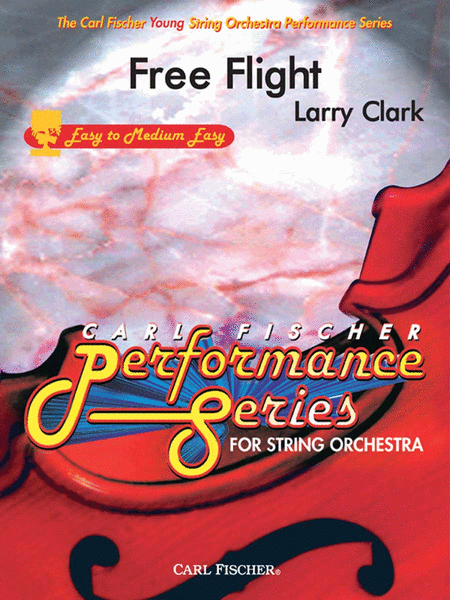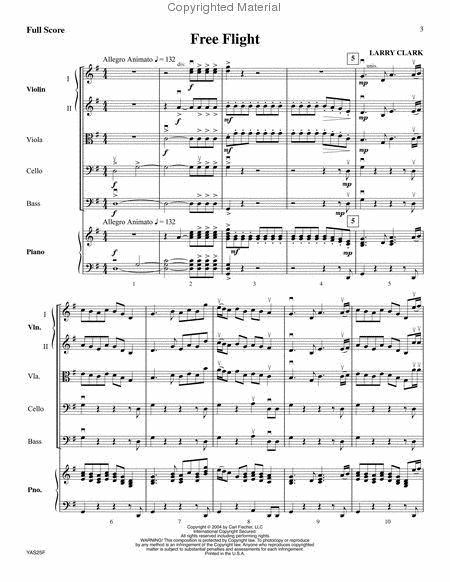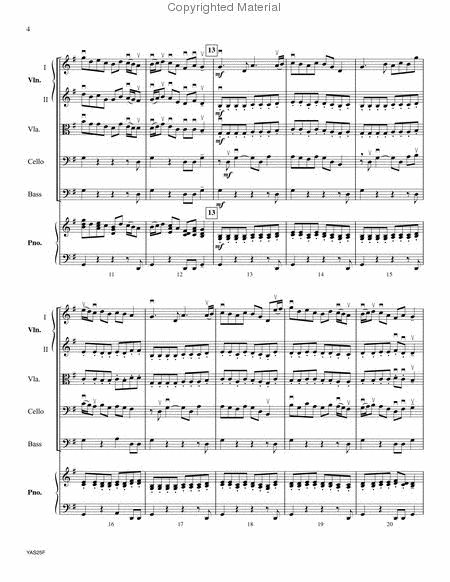Free Flight
-
Ships in 1 to 2 weeks
Details
Description
SKU: CF.YAS25
Composed by Larry Clark. SWS-FS. Carl Fischer Young String Orchestra Series. Classical. Score and Parts. With Standard notation. 16+16+10+10+4+4+10+12 pages. Carl Fischer Music #YAS25. Published by Carl Fischer Music (CF.YAS25).ISBN 9780825854972. UPC: 798408054977. 8.5 X 11 inches. Key: G major.
This piece calls to mind the sensation of a glider floating freely on the wind. With its soaring melodic lines, strong rhythmic pulse, and easy playability, this tune is sure to become a favorite with your young orchestra players.
Free Flight is a whimsical composition created to depict the sensation of floating as if flying in a glider. As such, the main theme should have a musical contour that helps to define the effervescent quality of the work. Along with this, the tempo should be forward moving, but not too fast as to lose the ability to play the melody with this expressive quality. Some conductors may choose to feel this piece in 2 rather than the last 4. After a brief introduction the piece takes off into the first statement of the theme. More motion is added on the repeat of the theme with a soaring countermelody in the cellos. This is followed by the second theme that is somewhat of an inversion of the first theme and is carried by the cellos. The first theme then returns and then is followed by an extension of the cadence taken by the violas. A more lyrical section is then stated with the lower voices pizzicato, which then leads to a return of the second theme with different orchestration before the final statement of the main theme. The piece concludes with a short coda that accelerates in tempo for an exciting finish. This piece also provides an opportunity for the viola section to shine. There are cues written for the important viola parts in the cello and violin II if they are necessary. As with all of my pieces for younger students, feel free to adjust the tempo and bowings to fit the needs of your student. It has been my pleasure to have the opportunity to write this piece. I hope you and your students find it useful in your program. LARRY CLARK Lakeland, Florida 2004.
Free Flight is a whimsical composition created to depict the sensation of floating as if flying in a glider. As such, the main theme should have a musical contour that helps to define the effervescent quality of the work. Along with this, the tempo should be forward moving, but not too fast as to lose the ability to play the melody with this expressive quality. Some conductors may choose to feel this piece in 2 rather than the last 4. After a brief introduction the piece takes off into the first statement of the theme. More motion is added on the repeat of the theme with a soaring countermelody in the cellos. This is followed by the second theme that is somewhat of an inversion of the first theme and is carried by the cellos. The first theme then returns and then is followed by an extension of the cadence taken by the violas. A more lyrical section is then stated with the lower voicesA pizzicato, which then leads to a return of the second theme with different orchestration before the final statement of the main theme. The piece concludes with a short coda that accelerates in tempo for an exciting finish. This piece also provides an opportunity for the viola section to shine. There are cues written for the important viola parts in the cello and violin II if they are necessary. As with all of my pieces for younger students, feel free to adjust the tempo and bowings to fit the needs of your student. It has been my pleasure to have the opportunity to write this piece. I hope you and your students find it useful in your program. LARRY CLARK Lakeland, Florida 2004.
Free Flight is a whimsical composition created to depict the sensation of floating as if flying in a glider. As such, the main theme should have a musical contour that helps to define the effervescent quality of the work. Along with this, the tempo should be forward moving, but not too fast as to lose the ability to play the melody with this expressive quality. Some conductors may choose to feel this piece in 2 rather than the last 4. After a brief introduction the piece "takes off" into the first statement of the theme. More motion is added on the repeat of the theme with a soaring countermelody in the cellos. This is followed by the second theme that is somewhat of an inversion of the first theme and is carried by the cellos. The first theme then returns and then is followed by an extension of the cadence taken by the violas. A more lyrical section is then stated with the lower voicesA pizzicato, which then leads to a return of the second theme with different orchestration before the final statement of the main theme. The piece concludes with a short coda that accelerates in tempo for an exciting finish. This piece also provides an opportunity for the viola section to shine. There are cues written for the important viola parts in the cello and violin II if they are necessary. As with all of my pieces for younger students, feel free to adjust the tempo and bowings to fit the needs of your student. It has been my pleasure to have the opportunity to write this piece. I hope you and your students find it useful in your program. LARRY CLARK Lakeland, Florida 2004.
Free Flight is a whimsical composition created to depict the sensation of floating as if flying in a glider. As such, the main theme should have a musical contour that helps to define the effervescent quality of the work. Along with this, the tempo should be forward moving, but not too fast as to lose the ability to play the melody with this expressive quality. Some conductors may choose to feel this piece in 2 rather than the last 4. After a brief introduction the piece "takes off" into the first statement of the theme. More motion is added on the repeat of the theme with a soaring countermelody in the cellos. This is followed by the second theme that is somewhat of an inversion of the first theme and is carried by the cellos. The first theme then returns and then is followed by an extension of the cadence taken by the violas. A more lyrical section is then stated with the lower voices pizzicato, which then leads to a return of the second theme with different orchestration before the final statement of the main theme. The piece concludes with a short coda that accelerates in tempo for an exciting finish. This piece also provides an opportunity for the viola section to shine. There are cues written for the important viola parts in the cello and violin II if they are necessary. As with all of my pieces for younger students, feel free to adjust the tempo and bowings to fit the needs of your student. It has been my pleasure to have the opportunity to write this piece. I hope you and your students find it useful in your program. LARRY CLARK Lakeland, Florida 2004.
Free Flight is a whimsical composition created to depict the sensation of floating as if flying in a glider. As such, the main theme should have a musical contour that helps to define the effervescent quality of the work. Along with this, the tempo should be forward moving, but not too fast as to lose the ability to play the melody with this expressive quality. Some conductors may choose to feel this piece in 2 rather than the last 4. After a brief introduction the piece "takes off" into the first statement of the theme. More motion is added on the repeat of the theme with a soaring countermelody in the cellos. This is followed by the second theme that is somewhat of an inversion of the first theme and is carried by the cellos. The first theme then returns and then is followed by an extension of the cadence taken by the violas. A more lyrical section is then stated with the lower voices pizzicato, which then leads to a return of the second theme with different orchestration before the final statement of the main theme. The piece concludes with a short coda that accelerates in tempo for an exciting finish. This piece also provides an opportunity for the viola section to shine. There are cues written for the important viola parts in the cello and violin II if they are necessary. As with all of my pieces for younger students, feel free to adjust the tempo and bowings to fit the needs of your student. It has been my pleasure to have the opportunity to write this piece. I hope you and your students find it useful in your program. LARRY CLARK Lakeland, Florida 2004.
Free Flight is a whimsical composition created to depict the sensation of floating as if flying in a glider. As such, the main theme should have a musical contour that helps to define the effervescent quality of the work. Along with this, the tempo should be forward moving, but not too fast as to lose the ability to play the melody with this expressive quality. Some conductors may choose to feel this piece in 2 rather than the last 4. After a brief introduction the piece "takes off" into the first statement of the theme. More motion is added on the repeat of the theme with a soaring countermelody in the cellos. This is followed by the second theme that is somewhat of an inversion of the first theme and is carried by the cellos. The first theme then returns and then is followed by an extension of the cadence taken by the violas. A more lyrical section is then stated with the lower voices pizzicato, which then leads to a return of the second theme with different orchestration before the final statement of the main theme. The piece concludes with a short coda that accelerates in tempo for an exciting finish.This piece also provides an opportunity for the viola section to shine. There are cues written for the important viola parts in the cello and violin II if they are necessary. As with all of my pieces for younger students, feel free to adjust the tempo and bowings to fit the needs of your student.It has been my pleasure to have the opportunity to write this piece. I hope you and your students find it useful in your program.LARRY CLARKLakeland, Florida 2004.
About Carl Fischer Young String Orchestra Series
This series of Grade 2/Grade 2.5 pieces is designed for second and third year ensembles. The pieces in this series are characterized by:
--Occasionally extending to third position
--Keys carefully considered for appropriate difficulty
--Addition of separate 2nd violin and viola parts
--Viola T.C. part included
--Increase in independence of parts over beginning levels



 Share
Share